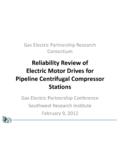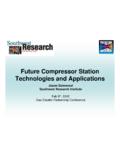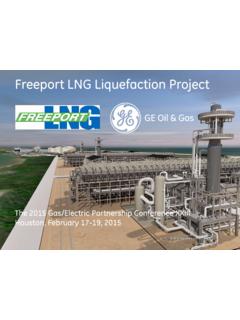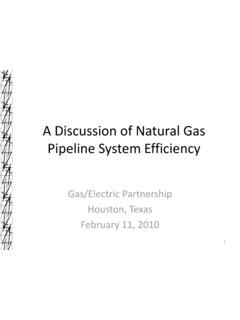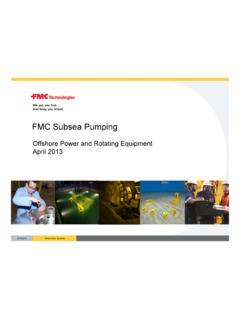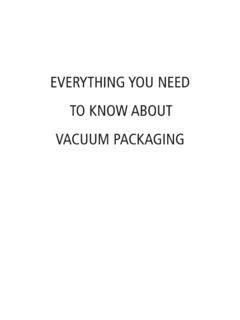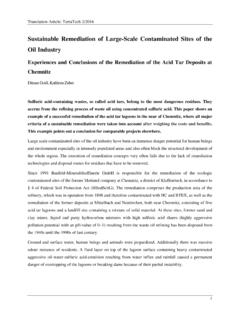Transcription of Operating Catalytic Emission Reduction Systems
1 Operating Catalytic Emission Reduction Systems Presented by Southern California Gas Company Larry Sasadeusz Engineering Analysis Center Manager Gregg Arney Air Quality and Compressor Services Team Leader Gas/Electric Partnership 2008 Workshop Houston, Texas January 30-31, 2008. Regulatory drivers State command and control regulations due to non-attainment of National Ambient Air Quality Standards New Source Review Prevention of Significant Deterioration (PSD). National Emission Standards for Hazardous Air Pollutants (NESHAP) MACT. State health and safety laws Control Devices NOx Reduction Selective Catalytic Reduction (SCR). Selective Non- Catalytic Reduction (SNCR).
2 Lean NOx Trap (SCONOX ). SNCR w/additional firing (NOxTECH ). Water or steam injection (turbines). PCC, Enhanced Mixing, EGR, PSC (engines). CO, VOC, and HAP Reduction oxidation Catalyst 3-way Reduction of NOx, CO, VOC, and HAP. Non-Selective Catalytic Reduction system (NSCR). The focus of this presentation is the two most Control Devices common control Systems used in the pipeline industry. NOx Reduction Selective Catalytic Reduction (SCR). Selective Non- Catalytic Reduction (SNCR). Lean NOx Trap (SCONOX ). Applicable to SNCR w/additional firingturbines (NOxTECH ). and lean burn reciprocating Water ortosteam Applicable rich injection (turbines). engines burn CO, reciprocating VOC, and HAP Reduction engines oxidation Catalyst 3-way Reduction of NOx, CO, VOC, and HAP.
3 Non-Selective Catalytic Reduction system (NSCR). SoCalGas Experiences Demonstrated and operated SCR on 2-stroke and 4- stroke lean burn engines in the 1980's through the early 1990's. Operated NSCR on rich burn engines since the mid- 1980's. This includes gas compression and power generation. Operated oxidation catalysts on lean burn engines since the mid 1990s, and will add many more in 2010. as a result of recent rule changes. Installed SCR and oxidation catalysts on three Solar Centaurs in 1993, with an additional unit installed in 2001. Selective Catalytic Reduction Ammonia is used to reduce NOx: .. Selective Catalytic Reduction A Continuous Emission Monitoring system (CEMS) NOx measurement is used as a feedback control to set ammonia injection rate.
4 Some ammonia slips through the catalyst unreacted. SCR is an ammonia driven system an ammonia exceedance occurs before NOx because the control system pumps in more ammonia to meet NOx set point. SCR Challenges The catalyst won't last long if the NH3 slip is the same as or near the NOx limit. oxidation catalyst can be added downstream of the SCR to oxidize NH3, but this creates more NOx. Johnson Matthey is working on an NH3. catalyst that converts NH3 to N2 and water. SCR Challenges Simple cycle turbine temperature is too hot at high loads for base metal catalysts. Use zeolite catalyst. Use a blower to cool the exhaust with ambient air when exhaust is over 800 F.
5 Increases catalyst space velocity (hr-1) which means more catalyst volume is needed. Blower power increases Operating costs. Simple cycle turbines can also exacerbated NH3 slip problems since NH3 disassociates to NOx at temperatures > 950 . Catalyst Performance vs. Temperature SCR Challenges Reagent (ammonia) is a hazardous material. Anhydrous hazardous 30% concentration aqueous ammonia 19% concentration aqueous ammonia Commonly chosen because it is in a less hazardous classification that doesn't require an Risk Management Plan. Need to strip water from ammonia or vaporize. Urea is commonly used because it is non-hazardous More complex material handling process Nozzle fouling; side reactions SoCalGas permitted one engine using carbamate.
6 BACT Determination BACT is Best Achievable Control Technology BACT Determination is defined in: EPA New Source Review Workshop Manual, Draft, October 1990. South Coast AQMD BACT Guidelines, latest update August 17, 2000. Achieved in Practice (AIP). Control technology is demonstrated as AIP. for a specific source class or category if: It is COMMERCIALLY AVAILABLE. It is RELIABLE when Operating for at least 183. cumulative days at a minimum of 50% design capacity, OR in a manner that is typical of the equipment in order to provide an expectation of continued reliability of the control technology. Turbine NOx and Catalyst Efficiency versus Time Catalyst Efficieny Turbine NOx Time Wheeler Ridge Class and Category.
7 Originally permitted at 3 hour rolling averages: 5 ppm NOx at steady state conditions 8 ppm NOx during load transitions 20 ppm slip The air district established this BACT level based on the performance of combined cycle turbines, and a single installation where the SCR. was installed upstream of the heat recovery. Wheeler Ridge Class and Category . 27 variances later, it was obvious that Wheeler Ridge was different. Simple cycle. Variable loads. Frequent starts and stops. Wheeler Ridge was a separate Class and Category which required a new BACT. determination. Wheeler Ridge Class and Category . The original catalyst was replaced with a high temperature zeolite washcoat catalyst manufactured by BASF (formerly Engelhard.)
8 Catalyst performance was trended over a 2- year period to verify achievable limits. The facility is now permitted at: 8 ppm NOx at steady state conditions 12 ppm NOx during load transitions 20 ppm slip Activity versus Running Hours (ZNX). 1. Predicted Activity from Laboratory Testing of Field Samples Activity (Aged/Fresh). 5 ppm N Ox Predicted Activity from 8 ppm N Ox Field system Performance Minimum activity required lines 0 2 4 6 8 10 12 14. Running Hours (Thousands). SCR Recommendations Design the system for end-of-cycle conditions Turbine just prior to re-build Catalyst designed for a 3 year life as a good engineering practice . Install extra test ports in the catalyst housing Test ports to confirm uniform flow through catalyst (suggest CFD analysis).
9 Test ports between catalyst beds to check performance of the lead bed. SCR Recommendations Develop sparing / replacement catalyst philosophy that includes the ability to install a third bed. Develop program to track catalyst performance and predict failures. Unit 401 Field Test 30 NOx ppmc 25 NH3, ppmc mole NH3/NOx NH3 / NOx mole ratio 20 NOx/NH3 ppm 15 10 5 0 9:00 9:42 10:24 11:06 11:48 12:30 13:12 13:54 14:36. SCR Recomendations The log log plot of the performance test results can be used to predict life. Life prediction is important because it can take months to procure replacement beds. Do economic analysis to determine life cycle cost advantage of controlling turbine NOx emissions (low NOx combustors, water injection, etc.)
10 Vs. increased cost of reagent. Ammonia slip limit must be distinctly higher than NOx limit. NSCR. Non Selective Catalytic Reduction Applicable to rich burn engines running near stoichiometry. Simultaneous Reduction of NOx, CO, and unburned hydrocarbons in a single catalyst. oxidation of CO and hydrocarbons is preferential, so the exhaust must have a reducing chemistry ( very little oxygen available.). Typical exhaust oxygen levels are less than upstream of the catalyst. Chemistry Engine exhaust chemistry must be the right soup . of ingredients to make NSCR work. NSCR Reactions (without balancing equations and ignoring intermediate reactions). CO + O2 CO2.
